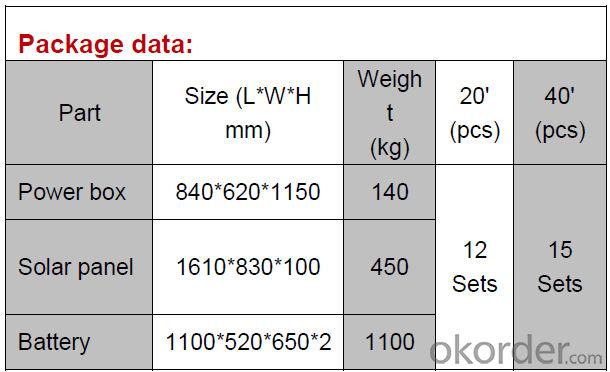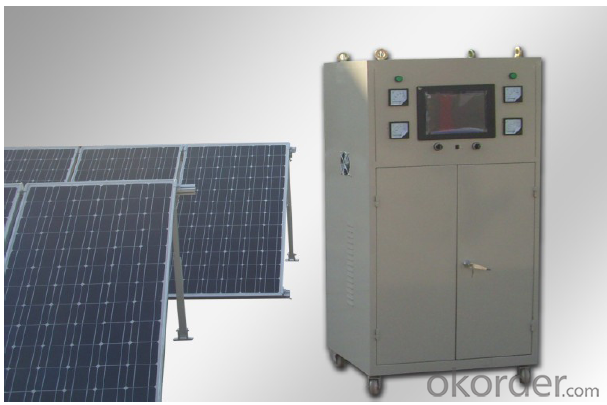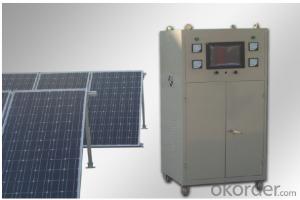Solar Home System CNBM-K8 5KW with Low Price
- Loading Port:
- China main port
- Payment Terms:
- TT OR LC
- Min Order Qty:
- 1 watt
- Supply Capability:
- 100000000 watt/month
OKorder Service Pledge
OKorder Financial Service
You Might Also Like
Item specifice
Description:
CNBM Solar is a world top leading solar manufacturer . With China government backup ,CNBM has set up
many warehouses in the world
The capacity of CNBMSolar is reach to 1GW, andmake sure each year our shipment capacity is more
Than 700-800MWs, at the same time, wehave set up the largest solar power station with our partner
in Ukraine.
CNBM is a Quality + Service orientedcompany with“Excellence at Each Step” approach, composed of
the finest components from TUV andIEC-certified partners around the world, CNBM modules consistently
undergo a variety of trials at thecompany’s Test & Development Centre, ensuring peak performance
capabilities. The company iscommitted to develop and provide the world with clean and renewable energy
to ease the energy shortages as wellas human kind’s impact on the environment.
Data:




FAQ:Could you introduce more about CNBM ?
CNBM is abbreviation of China National Building Material Corp .It is a state owned company . One of Global Fortune 500 .
- Q:How do solar energy systems integrate with other renewable energy sources?
- Solar energy systems can integrate with other renewable energy sources through a process called hybridization. This involves combining solar power with other sources such as wind, hydro, or biomass to create a more reliable and consistent energy supply. By diversifying the mix of renewable sources, hybrid systems can optimize energy generation, reduce intermittency issues, and enhance overall system efficiency. Additionally, advanced technologies like energy storage systems can be integrated with solar energy to store excess power for later use, further enhancing the integration and reliability of renewable energy sources.
- Q:Can solar energy systems be used in areas with high levels of air humidity?
- Solar energy systems can indeed be utilized in regions where air humidity is high. Although high humidity may have an impact on certain components, like diminishing the effectiveness of solar panels, it does not render solar energy systems completely inoperable. In reality, solar energy systems are implemented and function successfully in numerous high-humidity regions worldwide. Moreover, technological and design advancements have enhanced the performance of solar panels in humid conditions. To illustrate, anti-reflective coatings on the panels can prevent moisture accumulation and ensure better efficiency. All in all, while humidity might slightly affect the efficiency of solar energy systems, it does not impede their usage in areas with elevated air humidity.
- Q:How does shading affect the performance of solar energy systems?
- Shading can significantly impact the performance of solar energy systems by reducing the amount of sunlight that reaches the solar panels. This decreases the overall energy production and efficiency of the system. Even partial shading on a small portion of the panels can lead to significant power losses, as solar panels are interconnected and work as a whole. Therefore, it is crucial to design solar installations in areas with minimal shading to maximize their performance and optimize energy generation.
- Q:What are the components of a solar energy system?
- A solar energy system is composed of several essential elements that collaborate to harness the sun's power and convert it into usable electricity. The primary constituents of a solar energy system are as follows: 1. Solar Panels: These are the most recognizable aspect of a solar energy system. Solar panels, also known as photovoltaic (PV) panels, comprise multiple solar cells that convert sunlight into direct current (DC) electricity. They are typically installed on the roof or ground to capture sunlight. 2. Inverter: The DC electricity generated by the solar panels must be converted into alternating current (AC) electricity, which is the type of electricity used in homes and businesses. An inverter is responsible for this conversion process, ensuring that the electricity can be utilized by various appliances and devices. 3. Mounting System: To securely position solar panels on rooftops or the ground, a mounting system is employed. This system consists of racking or frames that hold the panels in place and allow for optimal sunlight exposure. Additionally, the mounting system ensures that the panels are installed at the correct angle and orientation to maximize energy production. 4. Electrical Wiring: Proper electrical wiring is crucial for connecting the solar panels, inverter, and other components of the solar energy system. The wiring carries the electricity from the panels to the inverter and then to the building's electrical panel, where it can be distributed and used. 5. Batteries (Optional): In certain solar energy systems, batteries are included to store surplus electricity generated during the day for use during the night or periods of low sunlight. These batteries store the excess energy and release it when needed, enabling a more consistent and reliable power supply. 6. Monitoring System: Many solar energy systems are equipped with a monitoring system that enables users to track the performance and energy production of their system. Real-time data on energy generation, consumption, and savings can be accessed through a web-based platform or a smartphone app. 7. Grid Connection (Optional): Solar energy systems can be connected to the electrical grid, enabling excess electricity to be fed back into the grid when the system produces more energy than is being used. This process, known as net metering, allows homeowners to earn credits or receive compensation for the excess energy they generate. In conclusion, a solar energy system is a sophisticated and interconnected collection of components that collaborate to harness the sun's energy and convert it into usable electricity for various applications. These components enable individuals and businesses to reduce their reliance on traditional fossil fuel-based energy sources and contribute to a cleaner and more sustainable future.
- Q:Can solar energy systems be used in powering agricultural processing facilities?
- Yes, solar energy systems can be used to power agricultural processing facilities. Solar panels can be installed on the rooftops or surrounding land of these facilities to generate electricity. This renewable energy source can provide a reliable and cost-effective solution to meet the power requirements of various agricultural processing operations, such as drying, milling, refrigeration, and packaging. Additionally, solar energy systems can help reduce greenhouse gas emissions and dependence on fossil fuels, making them an environmentally sustainable choice for powering agricultural processing facilities.
- Q:Can solar energy systems be used for powering off-grid emergency response centers?
- Yes, solar energy systems can be used for powering off-grid emergency response centers. Solar panels can generate electricity from sunlight, which can be stored in batteries for use during emergencies or when the main power grid is unavailable. This sustainable and renewable energy source can provide a reliable power supply to ensure the continuous operation of critical equipment and communication systems in emergency response centers.
- Q:Can solar energy systems be used in powering restaurants or food chains?
- Yes, solar energy systems can definitely be used to power restaurants or food chains. Solar energy is a renewable and sustainable source of power that can help reduce operating costs and minimize the environmental impact of these establishments. Solar panels can be installed on rooftops or in open areas to capture sunlight and convert it into electricity. This electricity can then be used to power various operations in restaurants, such as lighting, refrigeration, cooking equipment, and air conditioning. By utilizing solar power, restaurants and food chains can not only save on their energy bills but also demonstrate their commitment to sustainability and green practices. Additionally, some governments offer incentives and tax benefits for businesses that choose to install solar energy systems, making it an even more attractive option. Overall, solar energy systems are a practical and environmentally-friendly solution for powering restaurants and food chains.
- Q:What is the role of solar charge controllers in regulating the charging of batteries?
- The role of solar charge controllers is to regulate the charging of batteries by managing the flow of electricity from the solar panels to the batteries. They ensure that the batteries are charged efficiently and safely by monitoring the voltage and current levels, and adjusting the charging parameters accordingly. This prevents overcharging, which can damage the batteries, and also protects against over-discharging, which can shorten their lifespan. Solar charge controllers act as a crucial intermediary between the solar panels and batteries, optimizing the charging process to maximize the battery's performance and longevity.
- Q:How do solar energy systems impact energy conservation efforts?
- Solar energy systems have a significant impact on energy conservation efforts by providing a sustainable and renewable source of power. By harnessing the sun's energy, these systems reduce the reliance on fossil fuels, which helps to mitigate greenhouse gas emissions and combat climate change. Additionally, solar energy systems promote energy independence and decentralization, allowing individuals and communities to generate their own electricity and reduce their dependence on traditional energy grids. Overall, solar energy systems play a crucial role in conserving energy and promoting a greener future.
- Q:Can solar energy systems be used in areas with limited resources?
- Yes, solar energy systems can be used in areas with limited resources. Solar energy is a renewable and abundant source of power that can be harnessed even in remote or underdeveloped regions. The installation and maintenance costs of solar systems have significantly decreased over the years, making them more accessible to communities with limited resources. Additionally, solar energy systems can provide electricity and heat without relying on external fuel sources, reducing the dependence on expensive imports. Overall, solar energy offers a sustainable and viable solution for areas with limited resources, helping to meet their energy needs and enhance their socio-economic development.
1. Manufacturer Overview |
|
|---|---|
| Location | |
| Year Established | |
| Annual Output Value | |
| Main Markets | |
| Company Certifications | |
2. Manufacturer Certificates |
|
|---|---|
| a) Certification Name | |
| Range | |
| Reference | |
| Validity Period | |
3. Manufacturer Capability |
|
|---|---|
| a)Trade Capacity | |
| Nearest Port | |
| Export Percentage | |
| No.of Employees in Trade Department | |
| Language Spoken: | |
| b)Factory Information | |
| Factory Size: | |
| No. of Production Lines | |
| Contract Manufacturing | |
| Product Price Range | |
Send your message to us
Solar Home System CNBM-K8 5KW with Low Price
- Loading Port:
- China main port
- Payment Terms:
- TT OR LC
- Min Order Qty:
- 1 watt
- Supply Capability:
- 100000000 watt/month
OKorder Service Pledge
OKorder Financial Service
Similar products
New products
Hot products
Hot Searches
Related keywords



























